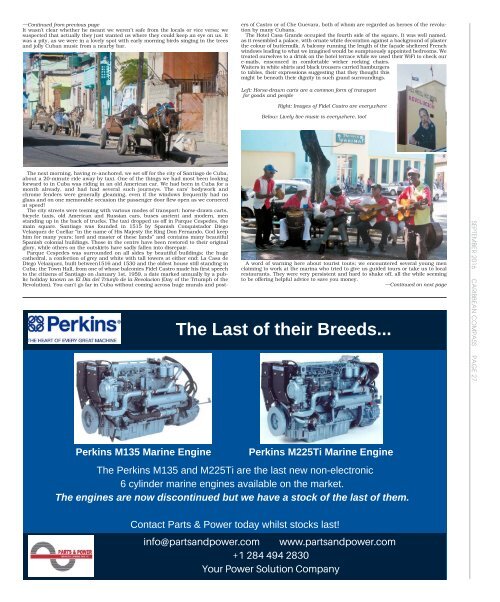Caribbean Compass Yachting Magazine September 2016
Welcome to Caribbean Compass, the most widely-read boating publication in the Caribbean! THE MOST NEWS YOU CAN USE - feature articles on cruising destinations, regattas, environment, events...
Welcome to Caribbean Compass, the most widely-read boating publication in the Caribbean! THE MOST NEWS YOU CAN USE - feature articles on cruising destinations, regattas, environment, events...
You also want an ePaper? Increase the reach of your titles
YUMPU automatically turns print PDFs into web optimized ePapers that Google loves.
— Continued from previous page<br />
It wasn’t clear whether he meant we weren’t safe from the locals or vice versa; we<br />
suspected that actually they just wanted us where they could keep an eye on us. It<br />
was a pity, as we were in a lovely spot with early morning birds singing in the trees<br />
and jolly Cuban music from a nearby bar.<br />
The next morning, having re-anchored, we set off for the city of Santiago de Cuba,<br />
about a 20-minute ride away by taxi. One of the things we had most been looking<br />
forward to in Cuba was riding in an old American car. We had been in Cuba for a<br />
month already, and had had several such journeys. The cars’ bodywork and<br />
chrome fenders were generally gleaming, even if the windows frequently had no<br />
glass and on one memorable occasion the passenger door flew open as we cornered<br />
at speed!<br />
The city streets were teeming with various modes of transport: horse-drawn carts,<br />
bicycle taxis, old American and Russian cars, buses ancient and modern, men<br />
standing up in the back of trucks. The taxi dropped us off in Parque Cespedes, the<br />
main square. Santiago was founded in 1515 by Spanish Conquistador Diego<br />
Velazquez de Cuellar “in the name of His Majesty the King Don Fernando, God keep<br />
him for many years; lord and master of these lands” and contains many beautiful<br />
Spanish colonial buildings. Those in the centre have been restored to their original<br />
glory, while others on the outskirts have sadly fallen into disrepair.<br />
Parque Cespedes was surrounded on all sides by beautiful buildings; the huge<br />
cathedral, a confection of grey and white with tall towers at either end; La Casa de<br />
Diego Velazquez, built between1516 and 1530 and the oldest house still standing in<br />
Cuba; the Town Hall, from one of whose balconies Fidel Castro made his first speech<br />
to the citizens of Santiago on January 1st, 1959, a date marked annually by a public<br />
holiday known as El Dia del Triunfo de la Revolucion (Day of the Triumph of the<br />
Revolution). You can’t go far in Cuba without coming across huge murals and posters<br />
of Castro or of Che Guevara, both of whom are regarded as heroes of the revolution<br />
by many Cubans.<br />
The Hotel Casa Grande occupied the fourth side of the square. It was well named,<br />
as it resembled a palace, with ornate white decoration against a background of plaster<br />
the colour of buttermilk. A balcony running the length of the façade sheltered French<br />
windows leading to what we imagined would be sumptuously appointed bedrooms. We<br />
treated ourselves to a drink on the hotel terrace while we used their WiFi to check our<br />
e-mails, ensconced in comfortable wicker rocking chairs.<br />
Waiters in white shirts and black trousers carried hamburgers<br />
to tables, their expressions suggesting that they thought this<br />
might be beneath their dignity in such grand surroundings.<br />
Left: Horse-drawn carts are a common form of transport<br />
for goods and people<br />
Right: Images of Fidel Castro are everywhere<br />
Below: Lively live music is everywhere, too!<br />
A word of warning here about tourist touts; we encountered several young men<br />
claiming to work at the marina who tried to give us guided tours or take us to local<br />
restaurants. They were very persistent and hard to shake off, all the while seeming<br />
to be offering helpful advice to save you money.<br />
—Continued on next page<br />
The Last of their Breeds...<br />
SEPTEMBER <strong>2016</strong> CARIBBEAN COMPASS PAGE 27<br />
Perkins M135 Marine Engine<br />
Perkins M225Ti Marine Engine<br />
The Perkins M135 and M225Ti are the last new non-electronic<br />
6 cylinder marine engines available on the market.<br />
The engines are now discontinued but we have a stock of the last of them.<br />
Contact Parts & Power today whilst stocks last!


















